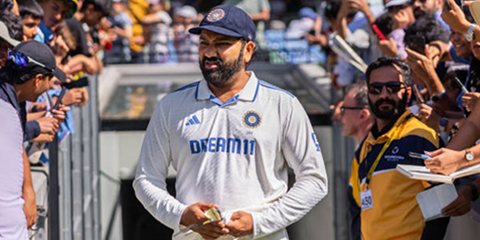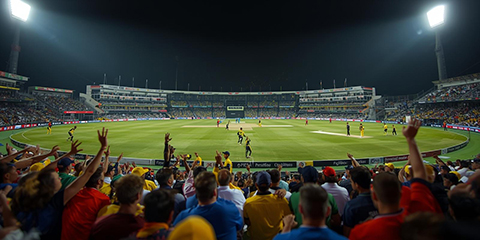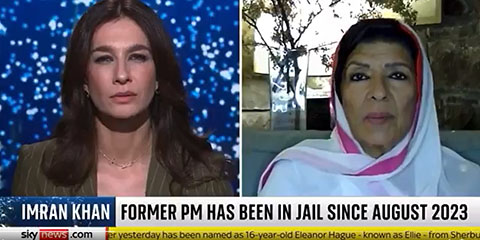The last stand: Rohit Sharma's Test career hangs in balance
JournalismPakistan.com | Published last year | Dr. Nauman Niaz (TI)
Join our WhatsApp channel
History of Test cricket is littered with tales of triumph, yet among them linger the shadowed narratives of captains, brilliant and brave, who were cast aside from the very stage they once commanded. Rohit Sharma, a man of understated charisma and unparalleled achievements, now finds himself within this lineage of tragic endings. As a successful captain dropped from the Test side, his plight echoes the silent lament of others who huddle the mantle of leadership only to have it torn away, leaving a legacy clouded by ignominy.
Rohit’s trajectory as a leader has been one of unobtrusive revolution. His captaincy has exuded calm pragmatism, a stark contrast to the fiery histrionics of some of his predecessors. In limited-overs cricket, he was the architect of India’s dominance, his methods meticulous and his vision unflinching. Yet, it is in Tests, the cauldron of cricketing identity, where his leadership found itself tethered to the interrupted flow of his own performances. When his runs fell silent, so too did the resonance of his authority, culminating in his unceremonious exit from the team.
Sour Endings
Such endings, however, are not unique to Rohit. Cricket’s history is replete with captains, brilliant in vision and valiant in execution, whose careers ended not in glory but in discord. One cannot help but recall the tale of Kim Hughes, the Australian captain who wept as he resigned, his leadership eroded by internal discord and a string of defeats. Hughes, like Rohit, was a man of principle, his leadership rooted in a philosophy that often clashed with the unforgiving demands of his era. Closer to Rohit’s narrative is that of Ian Botham, the charismatic English all-rounder who was axed from the captaincy amidst mounting losses and dwindling personal form.
Botham’s leadership, though spirited, was undone by the very forces he sought to galvanise , an unforgiving cricketing ecosystem where loyalty is fleeting and success the only currency of worth. Perhaps the most poignant comparison lies with Steve Waugh, the indomitable Australian who, despite his unrivalled record as a Test captain, was quietly phased out of the side as the selectors sought to facilitate and welcome a younger generation. Waugh’s exit, though cloaked in poise, illustrated the sting of a decision that prioritised the future over the present, an act of pragmatism that many argued was laced with ingratitude.
In these tales of fallen captains, one discerns a recurring motif: the cruel dichotomy of leadership. To lead is to inspire, to create a vision greater than oneself, yet it is also to invite scrutiny and to endure the weight of collective failure. The very act of leadership necessitates a surrender of individual identity to the demands of the team, a sacrifice that often goes unrewarded when the tide turns.
Philosophically, Rohit Sharma’s fall, like those before him, challenges cricket’s claim to be a sport of gentlemanly values. For all its traditions and aesthetics, the game remains, at its core, an arena of ruthless pragmatism. Captains, no matter how celebrated their achievements, are dispensable commodities in a system that venerates victory above all else. Their exits, often abrupt and unceremonious, are a stark reminder that cricket is a theatre where greatness is transient and gratitude scarce.
Yet, within this tragedy lies a paradoxical beauty. To be cast aside, to endure the ignominy of a fall from the top, is to reaffirm the humanity of these valued celebrities. Rohit Sharma’s career, marked by success and sacrifice, underscores the fragility of leadership and the resilience required to bear it. His dismissal from the Test team may sting, but it does not diminish the legacy he has sculpted as a player and a leader. In the end, the story of captains like Rohit, Hughes, Botham, and Waugh serves as a meditation on the cyclical nature of power and the impermanence of acclaim.
Leadership, for all its grandeur, is but a fleeting phase in the larger narrative of a cricketer’s life. What remains are not the circumstances of their exits but the principles they upheld, the victories they inspired, and the elegance and poise with which they faced the inevitable fall.
Rohit Sharma’s Tale
Rohit Sharma’s tale, though tinged with melancholy, is far from a conclusion. Like all great leaders, his legacy will endure not in the statistics of his tenure but in the memories of those he led, the moments he orchestrated, and the unrivaled dignity with which he accepted both triumph and defeat.
In the labyrinthine landscape of cricket, where triumph and travail coexist with cruel harmony, few narratives have been as poignant as that of Rohit Sharma. Once the enduring man of Indian cricket, his predicaments unwrap like a Shakespearean tragedy, fraught with intrigues, deceptions, and the inexorable erosion of legacy. Here lies a man whose skills spoke eloquently in yesteryears, sculpting symphonies of strokes that excelled mere numbers, yet now finds himself adrift in a sea of undervaluation, his crown slipping amidst insinuations of irrelevance.
To captain a cricketing team, especially in India, is to sit upon a throne of gilded nails. Rohit Sharma’s tenure, once lauded for its promise of consistency and calm, now elicits the scars of a narrative shaped by dwindling scores and unrelenting criticism. The runs, once a torrent, have slowed to a trickle, their absence amplifying the murmurs of dissent within and beyond the activity area. The sword of Damocles hangs precariously above him, as his role is dissected by the critics and connoisseurs with a precision that borders on malice, even mala fide.
Intrigues, those silent yet robust undercurrents of ambition, have further compounded his plight. Leadership in cricket is rarely about skills alone; it is a game of perceptions, alliances, and complex maneuvers. Rohit, in his moments of vulnerability, may well ponder the machinations of those who see opportunity in his fall. A captain's pedestal is as much a position of power as it is a target, and history has evidence how the very institution of cricket, for all its gentlemanly airs, has often been a stage for betrayal cloaked in strategic pragmatism.
And yet, perhaps the most stinging ridicule is the undervaluation of his achievements. A man whose artistry redefined the possibilities of white-ball batting, whose double hundreds dazzle as rare precedents in cricket’s history, now finds himself dismissed with an alarming haste. To be discarded while still the captain is not just an indignity; it is an existential infliction, a refutation of identity. For Rohit, whose batting often mirrored the languid elegance of a rhymester’s verses, the silence of his bat has tragically drowned the echoes of his past grandeur.
In this story of human frailty, one must confront the broader abstraction: the nature of impermanence. Cricket is a fickle mistress, the huddle is fleeting and judgments capricious. Rohit Sharma’s trials remind us that in the realm of the ephemeral, permanence is but an illusion. Yesterday’s hero is today’s pariah, and glory is only ever on lease. His predicament is not just his own but illustrative of a sport that exalts and exiles with equal fervour.
Yet, within this melancholy lies a flicker of resilience. For all its heartbreaks, cricket is a game of second acts, and its history is replete with those who, ousted or marginalized, returned to reclaim their narratives, nonetheless Rohit’s already 38 years old. Rohit’s career, though beset with fall outs and controversies , is far from its end. The batter that once silenced critics can yet perform again, excelling the intrigues and deceptions that now besiege him.
In the end, perhaps Rohit Sharma’s story is not one of runs and records but a parable of the human spirit’s capacity to endure. Amidst the melancholy of undervaluation and the reflections of betrayal, the phoenix of cricketing folklore awaits his reincarnation. And when he rises, it will be not just as a cricketer but as a substantiation of the invincibility of character, proving that even the most fragile offices can be reclaimed with fortitude. He needs to be there in white ball cricket, and if India needs to make an impact in the ICC Champions Trophy 2025, both Rohit and Virat Kohli would be required with an absolute peace of mind.
In cricket’s history, where artistry and ambition are entwined, Rohit Sharma’s career stands as a parable of brilliance and fallibility. Few cricketers have so exquisitely represented the dichotomy of genius and self-sacrifice, their triumphs tempered by the images of ill-fated decisions.
Reverence And Reproach
Yet, as his career now teeters between reverence and reproach, one is compelled to examine the philosophical undertones of his legacy, where noble intent has often clashed with the unforgiving realities of cricket. Rohit’s achievements are celebrated, revered. His batting, a symphony of elegance and power, remain unparalleled: three double centuries in ODIs, a feat as audacious as it is immortal; unparalleled dominance in white-ball formats; and a Test renaissance that silenced doubters who questioned his adaptability.
His artistry, reminiscent of a painter’s deft strokes, elevated cricket beyond the realm of competition into an aesthetic quest. Yet, as with all great artisans, his greatest strength, the pursuit of perfection would become his predicament. The turning point in his narrative arrived with India’s Test loss to England, a series where, barring an astounding century on a rank turner, his form deserted him in crucial times. The batter who once conjured tons of runs now was betrayed by his form, as his strokes lacked both conviction and timing.
This was followed by a pedestrian run against Bangladesh, furthermore the ignominy of a 3-0 defeat versus New Zealand, a home series that exposed the cracks in his batting and leadership. Here, one confronts selflessness and hubris, where the desire to take up the responsibility can paradoxically unravel the very balance one seeks to protect.
The Melbourne Test in Australia was a poignant example of this paradox. In a bid to fortify the batting order, Rohit dropped Shubman Gill, the young prodigy whose form and flair seemed destined for the number three position. Instead, he chose to open himself, relegating the dependable KL Rahul to an unnatural position at number three. The decision, though taken out of self-belief, disrupted the equipoise of the team. Manifestations were ignominious, since he failed miserably in both the innings. Rahul looked displaced and there seemed a chaos.
It was as though Rohit, in his quest to anchor the innings, inadvertently dismantled the harmony of a well-set melody. It was seen as an act of selfishness where he preferred his person ahead of team requirements. Philosophically, this moment invites reflection on the nature of leadership and sacrifice. Rohit’s decision to open was not a tactical misstep; it was symbolic of a deeper idealism, the belief that leadership necessitates personal risk, even at the cost of collective equilibrium.
In his mind, the act of stepping forward symbolised resilience, a statement of intent in the face of adversity. Yet, in the harsh calculus of cricket, ideals are often punished when they collide with pragmatism. The question arises: was Rohit’s selflessness a virtue or a tragic flaw? Or was it selfishness, self evasiveness. Leadership, after all, demands a delicate balance between individual courage and the broader interests of the team. His choice to bat at the top when totally out of form, to carry the burden of expectation on his shoulders, reflects a spirit unwilling to shrink from responsibility.
However, it was misconstrued and dropping of Shubam Gill and Rahul’s relegation backfired. He was lamented by all and sundry, all over the place. Even ex- captains began hounding him. And yet, the consequences, a disrupted batting order, faltering results, and personal decline, proposes that even the noblest intentions can unveil unintended outcomes.
Rohit Sharma’s career, therefore, is not only a reservoir of runs and records but a meditation on the human condition. It speaks to the tension between aspiration and limitation, between the desire to lead and the reality of fallibility. His triumphs remind us of cricket’s capacity to inspire, while his struggles illuminate its capacity to humble. In the end, Rohit’s story is unfinished, its denouement yet unwritten. Like a tragic hero in a Shakespearean play, he stands at the precipice of redemption or ruin, his fate as much a reflection of his choices as cricket’s inherent unpredictability.
Languid And Aesthetically Arresting
Languid and aesthetically arresting, Rohit Sharma personified an unending elegance as he emerged from the bustling suburbs of Mumbai, heralded as the heir apparent to India’s collection of batting greats from the early 2000s. The promise of his talent was unmistakable, though its blossoming was gradual, marked by patience and perseverance. By the start of the 2010s, however, he had ascended to monumental stature in white-ball cricket, captaining one of the most formidable T20 league teams of the modern era.
Rohit’s prodigious talent was evident to the discerning eye, the cricket literate and the passionate. Yet, there lingered a collective impatience, as though the world demanded immediate vindication of his latent genius. Critics weaponised the very word ‘talent,’ turning it into a acerbic appellation that haunted him across social media. But talent, unbending and overpowering, has a way of vindicating itself. For Rohit, the alchemy occurred in late 2012, when the inspired decision to promote him to opener in ODIs unleashed the full spectrum of his mastery. From that moment, his career unfurled with breathtaking clarity.
He authored double-centuries in ODIs with a frequency that bordered on the surreal. In the IPL, he shaped a legacy of six titles over the league’s first fifteen editions, a feat of persistent brilliance. The 2019 ICC World Cup witnessed to his high-flown dominance, as he amassed five centuries. When at last he was granted the opener’s role in Test cricket in 2019, he announced himself with three centuries in his maiden series, one of them an emphatic double.
There is a paradox at the heart of Rohit Sharma. His IPL signature, ‘Hitman,’ evokes images of instinctual force, yet his true skills lies in caressing the ball with an almost painterly elegance. Nonetheless, his ability to dispatch towering sixes with rhythmical inevitability became characteristic of his era. Once he surpassed fifty, a sense of inevitability hung in the air; the crowd did not only anticipate runs, they awaited the miraculous.
As a captain of the Mumbai Indians, Rohit demonstrated a temperament as poised as his batting. Leading them to five titles, he earned plaudits for his methodical approach, his embrace of technology, and his composure under pressure. In the national colours, he was an astute deputy to Virat Kohli in the limited-overs formats, spurring India to triumphs in Kohli’s absence. By 2022, he assumed the mantle of captaincy across all formats, an authentication to his maturity and leadership.
Rohit Sharma’s IPL Odyssey
Rohit’s IPL odyssey spans six titles: one with the Deccan Chargers and five as the captain of the Mumbai Indians, cementing him as the joint-most successful captain in league history. Joining Mumbai Indians in 2011 and taking over as captain in 2013, he led them to their inaugural title in his first season at the helm and subsequently steered the franchise for over ten years.
He remains MI’s all-time leading scorer and one of only four batters to have surpassed 6,000 IPL runs. His sole IPL century, a 109 not out against the Kolkata Knight Riders, came in 2012. The 2013 season marked his finest campaign with the bat, amassing 538 runs en route to Mumbai Indians’ title win. In 2015, his performance in the final earned him the Player of the Match accolade as MI triumphed over Chennai Super Kings. Under his stewardship, MI wrapped further titles in 2017, 2019, and 2020.
Yet, whatever the outcome, his cricket life serves as a poignant reminder of cricket’s deeper truths: that greatness is often fraught with contradictions, and that even the most luminous careers are but transient phases in the grand narrative of the sport. As Rohit Sharma continues his odyssey, one can only hope that the lessons of his trials will guide him toward a renewal of form and purpose. For in cricket, the possibility of reinvention remains ever within reach, a testimony to the incessant spirit of those who dare to dream, to lead, and to falter, yet rise again.
Furnace of Expectation
In the vast arena of cricket, where careers are forged in the furnace of expectation and scrutiny, Rohit Sharma's career emerges as an ode to understated brilliance. His career, a mosaic of achievements that sparkle with artistry and precision, speaks not only to the triumph of talent but also to the nuances of leadership and the intangible burden of impact. To observe Rohit Sharma’s career stream is to engage in a meditation on cricket’s deeper truths, where the quest of greatness is entwined with humility and resilience. From the outset, Rohit Sharma possessed the rare gift of incessant elegance and a poetic charm. His batting, a confluence of sophistication and power, has often felt less like a match with bowlers and more like a dialogue with the game itself.
There is poetry in his timing, an almost metaphysical sense of balance that elevates each stroke into something more profound than mere mechanics. His achievements in limited-overs cricket, most notably three double centuries in ODIs are not only statistical anomalies but reflections of a player who excels the ordinary. Yet, it is his leadership that casts a shadow long enough to rival his individual feats. Under his stewardship, the Mumbai Indians fashioned a dynasty in the Indian Premier League, a feat unparalleled in its consistency and dominance.
His captaincy has been marked not by the flamboyance of gesticulations or the fire or aggression, but by an inobtrusive assurance, a calm that diffuses through the ranks. Here is a leader who believes not in the thunder of commands but in the resonance of trust, a philosophy that echoes through his decisions and the loyalty of his teammates. The essence of Rohit’s leadership lies in its adaptability. In a world that often mistakes rigidity for strength, his ability to mould himself to the moment, to read the flow of a match, has been his hallmark. Unlike leaders who impose their will, Rohit listens, to the pitch, the opposition, and the pulse of his team. It is this fluidity, this capacity to concede without breaking, that defines his impact.
However, like all who dare to lead, Rohit’s career has not been devoid of challenges. In Tests, his journey has been one of delayed vindication. For years, skepticism surrounded his name, questioning his mettle in red ball cricket. When he finally found his stride as an opener, it was less a reinvention and more a rediscovery, proof that the finest players do not change who they are but deepen their understanding of what they can be.
Yet, leadership is a double-edged sword, and the burden of impact can sometimes weigh heavier than the accolades it brings. Rohit’s tenure as India’s captain has faced expectation, as his teams have both soared and faltered. It is at this juncture, amidst the delicate interplay of triumph and despair, that the arras of his legacy is being entwined. His serene countenance masks the tempest within, a quiet defiance against the erosion of form and the burden of a nation’s expectations. Once a source of stability, his red-ball prowess has withered, the decline beginning against Bangladesh and cascading through New Zealand and the turbulent series in Australia. At 38, the sands of time seem to receive inexorably, whispering that the end may be near. Yet, for one of his stature, the departure must not be dictated by circumstance or by an individual but by a deliberate reckoning, an elegiac farewell befitting the enormity of his contributions.
The broader landscape, however, reflects dissonance rather than harmony. Figures like Gautam Gambhir, an unlikely inheritor of the coaching mantle, ascend not through merit but by the invisible hand of political alignment. Gambhir’s tenure, marked by a nostalgic reluctance to embrace modernity, eschewing real-time analytics and advanced methodologies has seemingly cast the India dressing room into disarray. His stoic arrogance, an echo of his playing days, serves only to underscore his inability to excel his past self.
Rahul Dravid, incomparable in his sobriety, chose to step away after shepherding India to an ICC T20 World Cup victory in 2024, leaving a vacuum that seemed destined for celebrities like VVS Laxman or Woorkeri Raman. Their absence from consideration only deepens the disquiet. Within this cauldron of unresolved rivalries and divergent ambitions, figures like Virat Kohli and Rohit Sharma personify contrasting philosophies, their interactions infused with unspoken tension. Amidst this, the abrupt retirement of Ravichandran Ashwin midway through the ongoing series in Australia (Border Gavaskar Trophy 2024-2025) is a jarring coda, a poignant reminder of the crevices beneath the surface.
The narrative, for now, remains an unfinished manuscript, its pages heavy with unanswered questions. What becomes of a team ensnared in transition, where egos clash, and vision falters? And what of the individuals who, bound by history and circumstance, seek meaning amidst the chaos of their twilight years? Perhaps the answers lie not in resolution but in the enduring ambiguity of the human experience.
Philosophically, Rohit Sharma’s career invites reflection on the nature of greatness. In a sport obsessed with flamboyance, his is a legacy of uninterrupted revolution. He is not a man of grand gestures but of enduring substance, his impact resonating not through theatrics but through the deep, steady rhythm of consistency. He reminds us that leadership is not about command but about connection, not about domination but about direction.
The Lingua Franca of Greatness
In cricket, where numbers often form the lingua franca of greatness, his record stands as an eloquent authentication to his prowess. Across 67 Tests, two consecutive hundreds at the outset of his career (on debut and in his second Test), and a total of 4,301 runs at an average of 40.57 with twelve centuries, he deserves much more than what he has been given. In the shorter format, his feats become even more illustrious: 265 One-Day Internationals posting 10,866 runs at 49.16, adorned with three double centuries, eight monumental innings surpassing 150, and 31 centuries, each a monument to his mastery. Even the mercurial brevity of T20 cricket witnessed his genius, with five international hundreds illuminating his resume.
And yet, his career, rich in its weft and weave, was unceremoniously frayed. To be cast aside while bearing the mantle of captaincy is not only an affront to his statistics but a betrayal of the deeper essence of his contributions. Such a decision speaks not to cricketing logic but to the ethereal tendrils of politics and clandestine intrigues, which seem to have orchestrated his departure. It is in this intersection of merit and manipulation, of brilliance eclipsed by machination, that his story acquires a tragic poignancy, a cautionary tale for those who navigate the labyrinthine corridors of both sport and human ambition.
As he continues his journey, Rohit Sharma stands not only as a cricketer but as a symbol of cricket’s deeper virtues, patience, grace, and the unrelenting quest of betterment. His career is a reminder that the truest greatness often lies in its quietest moments, and that leadership, at its best, is an act of service. In the grand narrative of cricket, Rohit Sharma’s story will endure, not only for his runs or titles but for the philosophy he brought to the game. His achievements, his leadership, and his impact form a symphony that, like all great art, will resonate long after the applause has faded.
Dr. Nauman Niaz is a civil award winner (Tamagha-i-Imtiaz) in Sports Broadcasting and Journalism and a regular cricket correspondent, having covered 54 tours and three ICC World Cups. He has written over 3500 articles, authored 14 books, and is the official historian of Pakistan cricket (Fluctuating Fortunes IV Volumes – 2005). His signature show, Game On Hai, has received the highest ratings and acclaim.

























